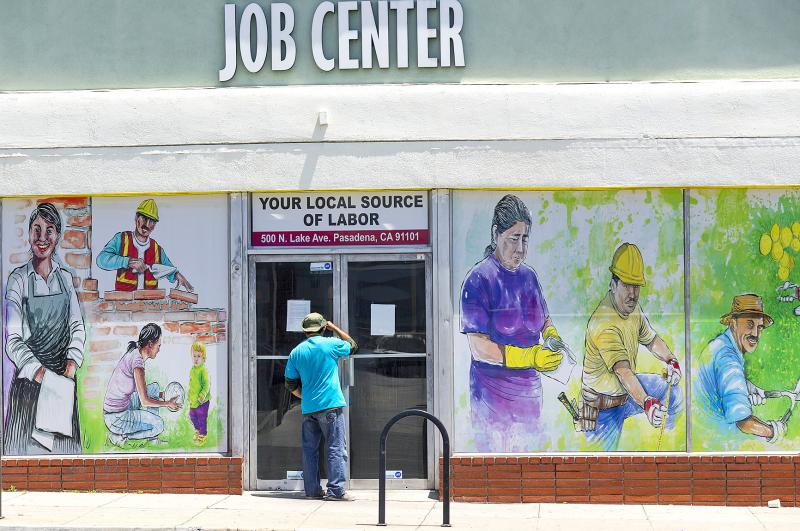To make good policy you should have at least a vague notion of what you are talking about.
However, when it comes to perhaps the biggest reform proposal around, we just do not. I am talking about a universal basic income (UBI), a system of unconditional cash payments to everybody in a given jurisdiction.
The case for a UBI runs as follows: It would reduce poverty, make people healthier and give them more dignity. It would also ease the transition of workers who lose their jobs to robots or artificial intelligence, so they can retrain for different careers. In general, it lets people bridge periods out of work or in bad jobs so they can invest in their own skills and re-enter the workforce at a higher level.

Photo: AP
To get out of a dead-end job, say, they might take a “sabbatical” for adult education. Or they could temporarily contribute in other valuable ways, for instance by homeschooling their children or caring for elderly parents.
Moreover, because a UBI would replace most or (as I would like) all legacy welfare systems, its cost need not be prohibitive.
Now the case against a UBI: It would devalue work as such and reward sloth. Without an existential need to work, why bother? A UBI would create a new and permanently dependent underclass, a lumpenproletariat of the Fourth Industrial Revolution. To provide the nectar that feeds these UBI drones, all those diligent worker bees who still have jobs would have to pay unacceptably high taxes.
This clash between cliches is what the debate has deteriorated to.
However, how, in fact, would most human beings respond to “free” money? We have not the faintest idea.
Lots of people have tried to find out, of course. Starting with Canada in the 1970s, various local, regional and national governments around the world have run experiments.
However, so far these have not yielded much useful information. Sometimes a new government took office and halted a research project or changed its parameters beyond recognition. Or the study was designed poorly.
UBI geeks were particularly disappointed that a Finnish project that began in 2017 was first changed, then stopped after only two years.
It, too, was not very well thought out — 2,000 Finns who were initially unemployed received a modest 560 euros (US$656 at the current exchange rate) a month and were compared against another group who continued to receive means-tested unemployment benefits.
To see the macroeconomic effect of a UBI, of course, you want to test it on a representative slice of the whole population, not just the jobless.
Nonetheless, as imperfect as the Finnish study was, it did debunk one assumption of UBI opponents. Getting unconditional payouts not only increased the well-being of the participating Finns, but also made them slightly more likely to find jobs. In short, they got healthier, but not lazier.
Now there is excitement about another research project getting started in Germany. It might finally get the parameters right. Almost 2 million people from all walks of life have already applied to be guinea pigs.
Starting next month, social scientists are to select two groups. One, consisting of 120 people, will get 1,200 euros a month, starting next spring and lasting three years. They will be compared against a control group of 1,380 who will be monitored, but will not get any cash.
The twist in this experiment is that the organizers are to look for “statistical twins.” So if among the 120 there is a 25-year-old pianist who lives in an urban metropolis, has five years of higher education and good health, she would have a doppelganger in the control group. So would the 40-year-old plumber from the countryside, the gig worker delivering Amazon packages, and so on.
By comparing these statistical twins over several years, said Juergen Schupp, the sociologist who leads the project, it should be possible to single out just the effects of the payments on people’s lives.
Eventually, they will even compare hair samples for clues about stress hormones. As usual in science, the results would not necessarily prove a positive — that a UBI turns us into entrepreneurs, for example.
However, they should be able to falsify bad arguments — that a UBI makes us lazy, perhaps.
Even this project, of course, will not try to answer every question. Which existing welfare services would a UBI replace? Would it extend even to migrants and temporary residents? How would it be financed?
However, it is a step in the right direction, and a reminder that policymakers in poor and rich countries alike need to keep an open mind.
We are indeed in the midst of a digital transformation that would destroy many old jobs and create many new ones, and we need structures that help people adapt.
As this year reminded us all, every now and then something like a pandemic-induced recession comes along, against which a UBI just might be an ideal policy tool. It would certainly help if we could answer some of the big questions.
Andreas Kluth is a columnist for Bloomberg Opinion. He was previously editor-in-chief of Handelsblatt Global and a writer for The Economist. He is the author of Hannibal and Me
This column does not necessarily reflect the opinion of the editorial board or Bloomberg LP and its owners.

‘SWASTICAR’: Tesla CEO Elon Musk’s close association with Donald Trump has prompted opponents to brand him a ‘Nazi’ and resulted in a dramatic drop in sales Demonstrators descended on Tesla Inc dealerships across the US, and in Europe and Canada on Saturday to protest company chief Elon Musk, who has amassed extraordinary power as a top adviser to US President Donald Trump. Waving signs with messages such as “Musk is stealing our money” and “Reclaim our country,” the protests largely took place peacefully following fiery episodes of vandalism on Tesla vehicles, dealerships and other facilities in recent weeks that US officials have denounced as terrorism. Hundreds rallied on Saturday outside the Tesla dealership in Manhattan. Some blasted Musk, the world’s richest man, while others demanded the shuttering of his

ADVERSARIES: The new list includes 11 entities in China and one in Taiwan, which is a local branch of Chinese cloud computing firm Inspur Group The US added dozens of entities to a trade blacklist on Tuesday, the US Department of Commerce said, in part to disrupt Beijing’s artificial intelligence (AI) and advanced computing capabilities. The action affects 80 entities from countries including China, the United Arab Emirates and Iran, with the commerce department citing their “activities contrary to US national security and foreign policy.” Those added to the “entity list” are restricted from obtaining US items and technologies without government authorization. “We will not allow adversaries to exploit American technology to bolster their own militaries and threaten American lives,” US Secretary of Commerce Howard Lutnick said. The entities

Minister of Finance Chuang Tsui-yun (莊翠雲) yesterday told lawmakers that she “would not speculate,” but a “response plan” has been prepared in case Taiwan is targeted by US President Donald Trump’s reciprocal tariffs, which are to be announced on Wednesday next week. The Trump administration, including US Secretary of the Treasury Scott Bessent, has said that much of the proposed reciprocal tariffs would focus on the 15 countries that have the highest trade surpluses with the US. Bessent has referred to those countries as the “dirty 15,” but has not named them. Last year, Taiwan’s US$73.9 billion trade surplus with the US

Prices of gasoline and diesel products at domestic gas stations are to fall NT$0.2 and NT$0.1 per liter respectively this week, even though international crude oil prices rose last week, CPC Corp, Taiwan (台灣中油) and Formosa Petrochemical Corp (台塑石化) said yesterday. International crude oil prices continued rising last week, as the US Energy Information Administration reported a larger-than-expected drop in US commercial crude oil inventories, CPC said in a statement. Based on the company’s floating oil price formula, the cost of crude oil rose 2.38 percent last week from a week earlier, it said. News that US President Donald Trump plans a “secondary